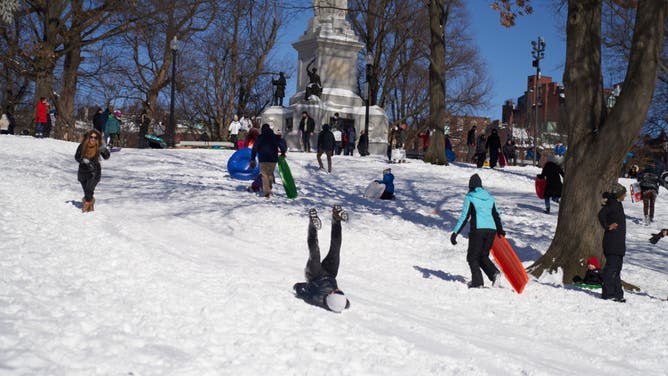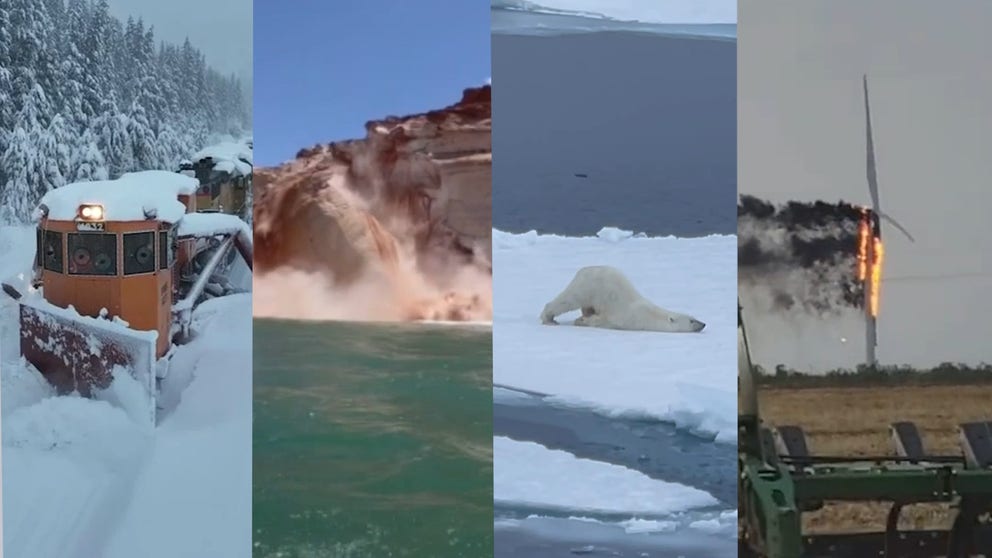Relive some of the wackiest weather records set in 2022
We went back and found some of the more unusual weather records set this year, along with which towns had the "smash hits" of 2022.
7 of the best extreme weather viral videos of 2022
From earthquakes to lightning strikes, here are some of the best extreme weather moments captured on camera in 2022.
Think of it as the meteorological version of the Billboard Top 100.
Breaking daily or monthly temperature or rainfall records is common throughout the year, but we went back and found some of the more unusual weather records set this year, along with which towns had the "smash hits" of 2022 – as in obliterating their previous weather records.
Most of the largest record breakers came during extreme weather, as you might expect.
Florida's rain records awash in new entries
The massive floods in July and Hurricane Ian left an indelible mark on rainfall records in the areas impacted by those events.
HOW TO WATCH FOX WEATHER ON TV
St. Louis set an all-time daily rainfall record of 8.64 inches on July 26, which was not only the No. 1 entry of beating a daily rainfall record among the nation's larger cities – breaking their previous daily record by 7.77 inches – but also smashed their all-time record by 3.05 inches, ranking No. 1 in that regard as well.
The following two entries came from Hurricane Ian when it hit Florida in late September. Orlando's Sanford Airport and Daytona Beach broke previous daily records by well over 5 inches.
‘Blizzard of ’22' erases snowfall records in New England
The blizzard that hit New England on Jan. 29 reset snowfall records across the region, with Islip, New York, getting 23.5 inches of snow, besting its daily record of 1.5 inches – a record smash of better than 1,500%.
Boston also broke its daily record by more than 20 inches, getting 23.6 inches on Jan. 29, whereas before 2022, the most snowfall recorded on the date was 3.1 inches.

Residents play in the snow at Boston Common park after a blizzard in Boston, Massachusetts, U.S., on Sunday, Jan. 30, 2022.
(Allison Dinner/Bloomberg / Getty Images)
Summer forgot to end in the West
If you tried to guess ahead of time which larger city smashed their daily record high temperature by the widest margin in 2022, I'd think you could have had 10 guesses and not come up with the answer: Seattle.
A blistering mid-autumn heatwave rewrote the record books across the Northwest, but Seattle took the top prize with a sweltering 88-degree high temperature – on Oct. 16. The previous record high was 72, and the 16-degree difference leads the way. A couple of fun facts: It's the second year in a row Seattle broke a daily high by such a margin. Last year, Seattle reached 108 degrees on June 28, besting the previous daily high (91 degrees) by 17 degrees. This autumn, after Seattle hit 88, four days later, it was in the 50s, and Seattle has not reached 60 degrees since.
Monterey, California, smashed its record high a few days later with a 91-degree reading on Oct. 19, breaking its previous record by 15 degrees.
Spring forgot to start in Montana
What about low temperatures? The biggest record dips were in the Inland Northwest.
Butte, Montana, dropped to negative 6 degrees on April 13 – yes, weeks into spring – breaking its previous record low for the day of 10 degrees.
Casper, Wyoming, matched the drop in March when on the 10th, the temperature dropped to negative 25 degrees, breaking the old record of negative 9 degrees.
Keep the eraser handy in Florida
Wondering which areas set the most weather records?
Marathon, Florida, spent many a day in 2022 editing its record books, tying or breaking 47 daily high-temperature records – that's more than 1 in 10 days this year.
On the flip side, Burns, Oregon, set or tied 15 low-temperature records.
For rainfall, three cities had ten dates with new rainfall records: Atlantic City, New Jersey; International Falls, Minnesota and Jackson, Kentucky.
Marquette, Michigan, led the way with new snowfall records with eight.
Other wild weather records of 2022
Aside from traditional high and low-temperature records, plenty of other rare and exciting weather events occurred throughout the year as proof that Mother Nature strives to keep us on our toes.
- The game-time temperature of 82 degrees at Los Angeles' SoFi stadium made for the second-hottest Super Bowl on record, according to the NFL's Pro Football Hall of Fame.
- The snow gauge at the University of California, Berkeley's Central Sierra Snow Lab went blank for 37 consecutive days in early 2022, just weeks after setting a record for most snowfall in December at 202.1 inches.
- Portland, Oregon, had its first measurable snowfall in April at 1.6 inches on April 11.
- Between Jan. 5 and March 16, Denver observed snow on eight of 11 Wednesdays.
- Sioux City, Iowa, had just 4.4 inches of snow in the winter of 2021-22 – their least snowy winter on record.
- During a late spring day on May 10, Traverse City, Michigan, dropped from 88 to 57 in 10 minutes as a sea breeze pushed through. During a cold winter day on Dec. 21, Cheyenne, Wyoming, dropped from 43 degrees to 3 degrees in 30 minutes – their largest half-hour temperature drop on record.
- Tallahassee, Florida, had its first freeze this season before Denver (h/t @SteveGlazier)
- Birmingham, Alabama, had its first freeze before Billings, Montana.
- Seattle had its driest 120-day stretch in city history this summer (0.54 inches). Portland, Oregon, went 67 days without measurable rain. The year will still finish above average for annual rainfall for both cities.
- Daytona Beach, Florida, hit 100 degrees on June 23 — the first time they had hit 100 since 1999.
- Vero Beach, Florida, set a record high (94 degrees - tie) and a record low (65) on June 23.
- Dallas went 67 consecutive days without measurable rain – their second-longest dry streak behind an 85-day streak in 2000. The streak ended on Aug. 10.
- On Aug. 22, Dallas set their record for one-hour rainfall, netting 3.01 inches in an hour. (h/t @maxar_weather)
- Utqiagvik, Alaska, (formerly known as Barrow) received 1.42 inches of rain on July 26 – their all-time wettest day and only the third time in history the town has had more than 1 inch of rain or rain-equivalent in a day. In contrast, sunny and warm Miami averages 18 days a year with 1 inch of rain or more.
- On Dec. 6, Utqiagvik set their all-time winter "heat" record at 40 degrees.
- A hailstone measuring 4.84 inches in diameter was found near Markerville, Alberta, on Aug. 1, setting the Canadian national record for the largest hailstone. The American record is a 7-inch hailstone found in Vivian, South Dakota.
- On Aug. 5, 1.46 inches of rain fell in Death Valley, just 0.01 inches off the all-time wettest day. The world-record holder for the hottest spot on the planet averages just over 2 inches of rain in a year. Rain fell again two weeks later on Aug. 25 – the first time in their weather records (since 1911) that measurable rain fell on that date. Three months later, a trace of rain would fall on Nov. 3 – also a first for the date.
- San Angelo, Texas, set a record for their town that no one wants: Reaching 100 degrees or hotter for 37 consecutive days.
- The top 5 hottest dates in September on record in Salt Lake City occurred within the same week this year.
